Foreign Insulators
by Marilyn Albers
Reprinted from "INSULATORS - Crown Jewels of the Wire", April 1983, page 5
Setting Values on Australian Insulators
There has been a real surge of interest in Australian insulators over
the last year. I attribute this to the increased amount of correspondence
between collectors in the U.S.A. and our collector pals over there in Australia.
Laura Van der Endt of Sidney, and Dawn Hole, who lives in Toowoomba, have both
been a tremendous help in sharing their knowledge about local insulators. And
contributing to the ease of correspondence is the fact that we can now look at
scale drawings of foreign insulators and refer to glass ones by C.D. numbers and
the porcelains by U-numbers.
It's quite a thrill to be able to write back and
forth about a U-2840 or a C.D. 590 and feel confident that both parties are
zeroing in on the same insulator! There are enough different glass and porcelain
insulators in Australia that were manufactured and/or used there, to where a
collector could specialize in this category and be genuinely concerned about
where to put them all. In fact, I already know of two or three who are beginning
to worry! Australia not only manufactured insulators, but imported them from
England, France, Japan, China, Taiwan, Finland, Korea and the U.S.A. The numbers
of these are endless!
So far, collectors passing insulators back and forth
between here and Australia have done so by way of "trades", rather
than any selling taking place. This has proved to be a lot of fun and takes us
back to the way it used to be in the good ol' days when the hobby was young. But
we need to watch out for something -- that we do not tell only the trade value of
our insulators, and then unknowingly accept something in trade that is worth far
more than we are giving back.
Insulator collecting in Australia is fairly new,
but already insulator displays are beginning to appear and are gaining dignity
at their local bottle shows. And because of the increased swapping with U.S.
collectors, the Australians are now able to ogle at C.D. 162 cobalt Hemi 19's,
C.D. 130 Cal. Electric Works, C.D. 206 "castles", etc. It will not be
long before the hobby will catch up to what it is here. In the meantime
Australian collectors are asking for help in arriving at comparable values based
on the rarity and availability of their insulators, so that trades will be fair.
This, of course, would apply to trades between collectors of any two countries.
British and American collectors are also busy swapping!
Basically, what I'm
saying is that we need to protect with a vengeance that trust we all value so
much in our hobby. I know it's not necessary to tell you this, but I'm going to
say it anyway: When you send an insulator in trade to a collector in a foreign
country, send one that's in mint condition, or, if this is not possible, at
least give the other party a chance to decline it before you mail. It's a long
way over there, and so you're not likely to get it back, because it's just not
worth the trouble and expense to return an insulator that proved to be a
disappointment; but you may be off the list the next time around!
A few mailing
tips: Pack the insulator so well you could drop it from your second story window
and have it survive intact. Avoid too many insulators per box. A good way,
whether packing one or several, is to put each one, well wrapped, into a small
cardboard box or coffee can and then place these into a larger box that's sturdy. Separate each unit with pieces
of Styrofoam, cardboard, foam rubber, or
newspaper "pads". Fill the box so there is no rattle. Tape the outside
of the box with plenty of nylon filament tape, then write FRAGILE in large block
letters. The cost of air mail is prohibitive, so the box usually goes the overland route, which is apt to take several weeks. That's a lot of miles and a
lot of hours for that insulator to be bumping around, so any extra efforts you
put into your packing job will pay off.
Labeling is important, too. It's a good
idea to avoid insuring the box, unless your friend is prepared to pay duty. If
you are trading, you can safely say "Used glass (porcelain) insulator(s),
gift to Collector -- no commercial value". So far this has proved to be a
happy situation for both parties involved: No duty, no opening of the box by
customs officials, and insulators have been coming through safely.
Through
several months of correspondence with both Dawn Hole and Laura Van der Endt,
I've been able to attribute some markings on Australian made porcelains that had
previously been a mystery to me.
R.F.Ltd, FOWLER, KP
These three markings are
commonly found on the U-1145 and U-1154, which are called trunk insulators and
are used on telephone lines. R.F. LTD stands for Robert Fowler Limited and
comes from the Fowler factories of Australia. Some insulators were marked simply
FOWLER, followed by the date. The variations in marking can be attributed to
the different generations and locations of the factories. I'm uncertain as to
where these factories were, but I'd bet on Sidney, for one, because so many
companies were located there. Insulator production by Fowler stopped altogether
in 1969, because they could not compete with the cheaper imports from England,
China and Japan. These three countries supplied the U-1154, as well as many other styles of insulators.
Another marking commonly found on these trunk insulators is KP. My Australian
friends tell me this stands for KOSTERS PREMIER POTTERIES, located in Adelaide.
This company was in business sometime before the 1930's, and production
stopped about 1978. Worldwide Porcelain Insulators, co-authored by Jack H. Tod
and myself, incorrectly reports that KP stands for KOPPLE POTTERIES. This was
based on incomplete information given by a supposedly knowledgeable collector,
and I welcome the opportunity to correct this error.
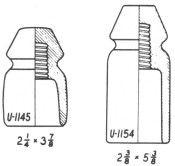
Drawings of the insulators
are shown here, followed by the markings and a photo of three of the U-1154's.
Notice the insulator on the far right. The glaze is half green and half white!
Laura tells me it is "an extremely uncommon" insulator, and we have
placed a trade/sale value of $50.00 on this one.
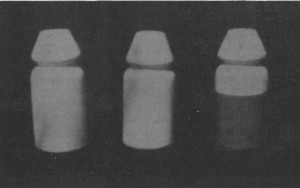

Various Markings Found on the
U-1502 and U-1503
At the time Worldwide Porcelain Insulators was published we
had not seen any marked specimens of these two insulators, even though many
hundreds of "no names" have been found in Australia. Dawn remarked
that because several companies produced these two insulator shapes, if there
were no markings, it would be difficult, indeed, to attribute any one to a
certain manufacturer. Recently, however, some of these particular insulators,
with markings, have been found on Australian lines. Drawings of the insulators,
with their markings, are shown below, followed by a photo of two of these that
belong to Laura Van der Endt.
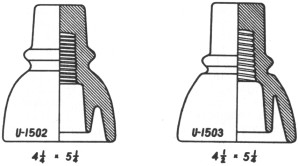
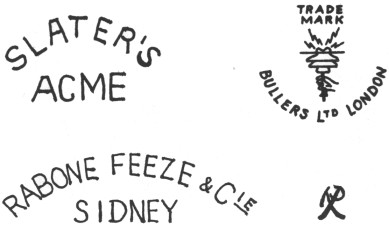

BULLERS, LIMITED is, of course, from England,
which should be no surprise, since we already know Australia imported many
British insulators. The U-1502 appeared in the Buller Jobson catalogue of 1895
and was designated "Australia". SLATER'S ACME is a local manufacturer,
but at the present time we have no further information on this one. The crossed
T and P constitutes the trademark of TURKU POTTERIES located in Turku, Finland,
which is proof that Australia did buy insulators from Finland, in spite of the
fact that the local Post Office claims to have no record of such a thing.
(Remember, the Post Office handles the communication system.) RABONE FEEZ &
CIE is obviously a manufacturer from Sidney; but all Laura's efforts to track
this one down have failed. It would seem that they are no longer in business.
Because of their scarcity, we have placed a value of $35.00 to $50.00 on the
U-1502's and 1503's with these markings. If you have these insulators with other
trademarks, please let me know, so we can keep our available information
updated.
Going on now to Australian glass insulators, let me share a few facts
I've learned since I wrote my column in the November '82 Crown Jewels.
C.D. 154
AGEE
This insulator, made by AUSTRALIAN GLASS MANUFACTURERS, in either greyish
green or SCA is not only scarce, as reported before, but virtually unobtainable,
especially the SCA! In Paul Keating's 1982 PRICE GUIDE no prices are given for
these. All you will see is OPEN. After conferring with Dawn and Laura, and based
on what we know now, we are saying $125.00 to $150.00 for the grey green
insulator and $250.00 for the SCA, both in mint condition. Dawn says, These were
used on lines in conjunction with Hemingray 42's and that this may account for
the American thread size. Unfortunately, these early lines all appear to be
history now." This would explain their scarcity now.
C.D. 490 AGEE
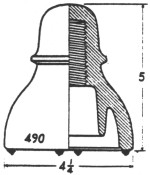
This insulator was
listed in the 1982 Price Guide under its old number only (C.D. 152.9) and
omitted in the section showing new C.D. numbers for foreign glass insulators
(490). You may want to write it in where it belongs, as this was an oversight.
You'll notice the suggested price for the 490 in various shades of purple and
greyish SCA to greyish green is given as $18.00. This is correct. However, the
narrow crown version with four large drips evenly spaced around the base is way
too low at $25.00. Like the C.D. 154 AGEE, it is just about impossible to find.
I would say no less than $150.00 for this one, mint. One retired glass worker
from Australian Glass Manufacturers (A.G.M.) in Sidney does not even remember
the C.D. 490 with four drips ever being made. But one must remember that few of
these companies kept past records.
The C.D. 490 in straw, with the wider crown
and smooth base, is a spectacular insulator. Just beautiful! Since this
insulator has just appeared on the scene here in the U.S.A., and there are only
about three of these, we are still a bit in awe over the color. Dawn Hole had
this explanation. She claims that, "The straw or peach color is the result
of using a decolorizer (selenium) in the glass ingredients after some years of
manufacture." As you know, manganese used to be added to glass in an
attempt to make it clear, but it was unsuccessful over the long haul, because
the sun's rays eventually turned the glass to an amethyst color. Now, with what
Dawn tells us, we can still uphold the theory that all 490's could have been
made as clear glass, and only the ones with the selenium decolorizer remained
so.
She goes on to say, "I have seen these straw 490's from New South Wales
and Queensland, and the only dates appearing on them are 1937 and 1938. Of
course there may be others." (Or perhaps they were only produced for those
two years, which accounts for their scarcity. - M.A.) "The latest, in
fact only, date I have seen on the SCA's is 1930. This tends to make the peach
490's fall into the category of replacement manufacture. Although the
manufacture of glass insulators in Australia began in 1926, no insulators that I
can find are dated before 1930. The P.M.G. (Post Master General ?) department
stipulated that insulators should show date of manufacture, but I cannot
establish when they first did. Looks like it could be 1930." At the present
time we are suggesting $100.00 for a mint 490 in straw. If someone finds a
barrel full, we'll take it from there; but Australian collectors are saying it's
super hard to find. How can we argue with that?
C.D. 590 A.G.M.
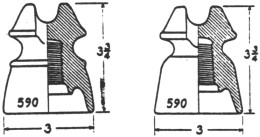
This is one of my favorite
insulators. It can be found in a dull light green, light yellow green, straw,
and dark amber. You'll notice the two drawings of C.D. 590 vary slightly, in
that one has a skirt ridge, and the other has a smooth skirt. The smooth skirt
version has only been seen in dark amber, and is the scarcest one of all. Mint
price for the greens is suggested at $50.00, for the straw at $70.00, and $80.00
for the dark amber. Quoting from The Glass Insulator in America by N. R.
Woodward, and referring to this insulator, we read, "One saddle groove
style was made in a very limited quantity for low voltage distribution work, but
it was not considered a success and was promptly discontinued." Since the
C.D. 590 was an experimental insulator, we can now understand why so few are to
be found.\
I have carried on long enough! I hope this will help you in your
endeavors to trade and mail insulators overseas, and let you know the mutually
agreed upon values of some of these rarer Australian gems you will be dealing
with. Many thanks to both Dawn and Laura for their input.
|
